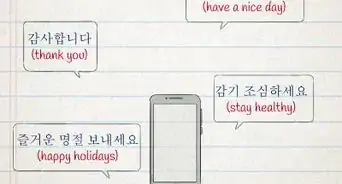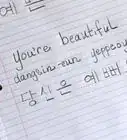This article was co-authored by wikiHow staff writer, Jennifer Mueller, JD. Jennifer Mueller is a wikiHow Content Creator. She specializes in reviewing, fact-checking, and evaluating wikiHow's content to ensure thoroughness and accuracy. Jennifer holds a JD from Indiana University Maurer School of Law in 2006.
There are 9 references cited in this article, which can be found at the bottom of the page.
wikiHow marks an article as reader-approved once it receives enough positive feedback. This article received 28 testimonials and 89% of readers who voted found it helpful, earning it our reader-approved status.
This article has been viewed 247,558 times.
Learn more...
Whether you're traveling in South Korea or want to socialize with a local Korean immigrant community, before you can start a conversation with someone, you need to introduce yourself. The Korean culture is formal and steeped in tradition, which can make introductions seem intimidating. However, as long as you speak politely and show respect, you'll be making new Korean friends in no time.[1]
Steps
Meeting New People
-
1Start by saying hello with "안녕하세요" (annyeong haseyo). You wouldn't simply walk up to someone and immediately tell them your name. Starting with a polite "안녕하세요" (annyeong haseyo) indicates respect for the person you're meeting for the first time.[2]
- If you're greeting a child for the first time, it's fine to simply say "안녕" (annyeong), which is the informal way to say "hello."
Tip: In Korean, there are formal, polite, and informal ways of speaking. The character 요 (yo) is an indication that you're using the polite way of speaking, which is acceptable anytime you're speaking to strangers, or to people older than you or in a position of authority.
-
2Bow politely as you say hello. The first time you greet someone, regardless of their age or station, it's polite to bow immediately after you say your greeting. Bend at the waist 15 to 30 degrees and then rise at the same speed as you lowered.[3]
- Close your eyes or keep them downcast as you bow. However, be alert for an extended hand. A handshake may accompany bows, particularly among men greeting other men.
Advertisement -
3Follow up with "잘지냈어요" (jal ji naet seo yo). A pleasant "how are you?" typically follows an initial greeting in any language.[4]
- You can also use "식사하셨어요?" (shiksa hashutsuyo?) This question literally means "Have you eaten?" However, it's a common way to ask "How are you?" in Korean culture. The typical response to this question is "네 했어요" (ae haeseoyo), which means "Yes, I've eaten." Keep in mind that despite the translation, if you're asked this question by someone, they aren't asking you to out to eat with them.
-
4Say "제이름은" (je ireumeun) followed by your name, then "입니다" (imnida). You might use your first or last name, whichever you're more comfortable with. However, keep in mind that Koreans typically address each other by their surnames unless they're well-acquainted.[5]
- For example, if your first name is Karen, you might say "je ireumeun Karen imnida."
- It's true that there are often "translations" for names in different languages, particularly European languages. However, this is not the case for Korean. Simply use your regular name.
- After introducing yourself, you might ask "이름이 무엇입니까?" (ireumi mueosimnikka?) This question means "what's your name?" When the person responds, you might say "반갑습니다" (bangapseumnida), which means "pleased to meet you."[6]
Respecting Korean Culture
-
1Make a deep bow when meeting someone for the first time. If you're introducing yourself to a friend of a friend or someone younger than you, a casual dip of the head may suffice. Otherwise, bow by bending forward from the waist at least 15 degrees. A deeper bow indicates greater respect.[7]
- If you're greeting someone older than you, of high social status, or in a position of authority, you may bow as much as 45 degrees forward, keeping your head lowered.
Tip: It would never be considered a mistake to bow too deeply. However, if you don't bow deeply enough, you might offend. For that reason, it's best to err on the side of a deeper bow.
-
2Shake hands with your right hand or with both hands. If you shake hands with someone when meeting them for the first time, always use your right hand, even if you're left-handed. If you are a man, keep in mind that Korean women typically wait for you to make the first move, so they may not extend their hand for a handshake unless you do first.[8]
- Using both hands is a sign of respect. You can also support your right wrist with your left hand as you shake the person's hand.
-
3Avoid direct contact with someone older or in a position of authority. When meeting someone older or in a position of authority for the first time, looking them directly in the eye is considered rude. It might be considered a challenge as well, as though you are questioning their authority or status. Looking slightly down is usually your best bet to avoid offense.[9]
- This can be difficult if you come from a Western culture that values eye contact. If you find yourself struggling, remain conscious of your eyes and look away quickly if you happen to make eye contact. Brief eye contact is no big deal, but sustained eye contact may be problematic.
-
4Address people by their title and surname. When you first introduce yourself, the person will likely introduce themselves by their title and surname. Continue to address them this way until they tell you otherwise. Given names (the equivalent of a first name in the West) are generally only used among people of the same age who are close friends.[10]
- There are many titles in Korea that are the equivalent of "father," "teacher," or "doctor." The title you use may depend on your relationship to the person. For example, if you introduce yourself to the parents of your Korean friend, they may want you to use the "father" and "mother" titles for them.
- If you don't know the right title to use with a person, add "씨" (ssi) to the end of their full name. This is the equivalent of using "Mr." or "Ms." in English. For example, if you are introduced to Mr. Kim Sung-Yoon and you didn't know any other title to use, you could address him as "Kimsungyoonssi."[11]
Community Q&A
Did you know you can get answers researched by wikiHow Staff?
Unlock staff-researched answers by supporting wikiHow
-
QuestionHow do you say the name "Genesis" in Korean?
 wikiHow Staff EditorThis answer was written by one of our trained team of researchers who validated it for accuracy and comprehensiveness.
wikiHow Staff EditorThis answer was written by one of our trained team of researchers who validated it for accuracy and comprehensiveness.
Staff Answer wikiHow Staff EditorStaff Answer
wikiHow Staff EditorStaff Answer -
QuestionIs SUBJECT-OBJECT-VERB the word order of a Korean sentence?
 wikiHow Staff EditorThis answer was written by one of our trained team of researchers who validated it for accuracy and comprehensiveness.
wikiHow Staff EditorThis answer was written by one of our trained team of researchers who validated it for accuracy and comprehensiveness.
Staff Answer wikiHow Staff EditorStaff Answer
wikiHow Staff EditorStaff Answer -
QuestionMy name is Lalita. I want my name to be written in Korean and what would be its pronounciation?
 wikiHow Staff EditorThis answer was written by one of our trained team of researchers who validated it for accuracy and comprehensiveness.
wikiHow Staff EditorThis answer was written by one of our trained team of researchers who validated it for accuracy and comprehensiveness.
Staff Answer wikiHow Staff EditorStaff Answer
wikiHow Staff EditorStaff Answer
References
- ↑ https://www.omniglot.com/language/phrases/korean.php
- ↑ https://theculturetrip.com/asia/south-korea/articles/korean-greetings-you-should-know/
- ↑ https://blogs.transparent.com/korean/hello-and-hi-in-korean/
- ↑ https://app2brain.com/learn-languages/korean/conversations/
- ↑ https://blogs.transparent.com/korean/as-a-tourist-in-korea-greeting-simple-conversation/
- ↑ https://theculturetrip.com/asia/south-korea/articles/15-korean-phrases-you-need-to-know/
- ↑ https://culturalatlas.sbs.com.au/south-korean-culture/south-korean-culture-greetings
- ↑ https://culturalatlas.sbs.com.au/south-korean-culture/south-korean-culture-greetings
- ↑ https://culturalatlas.sbs.com.au/south-korean-culture/south-korean-culture-communication
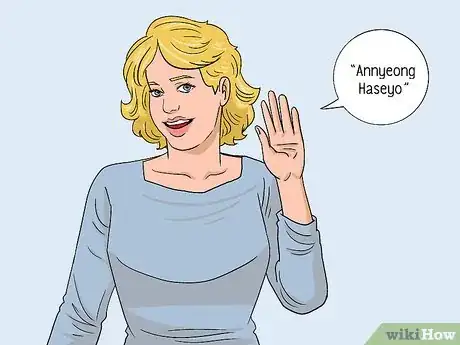


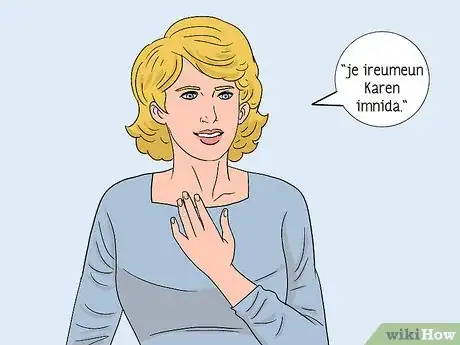

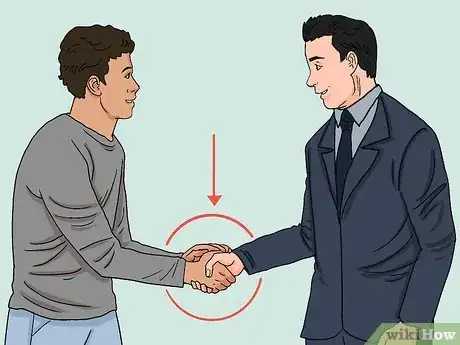
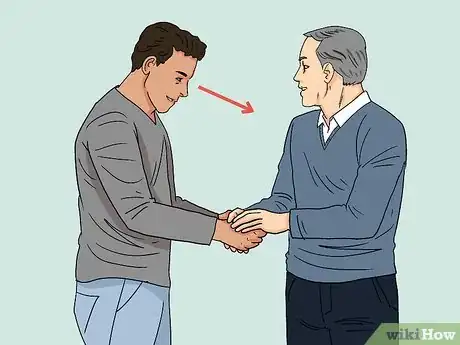
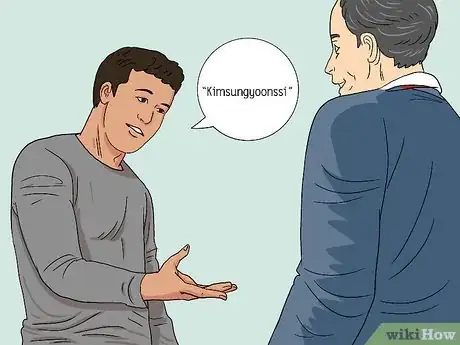
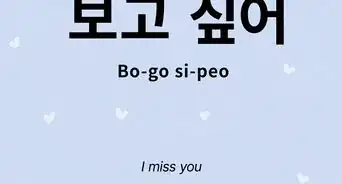

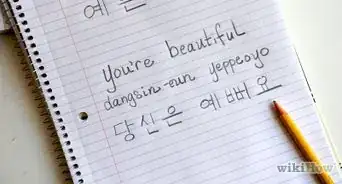


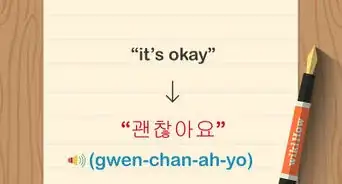
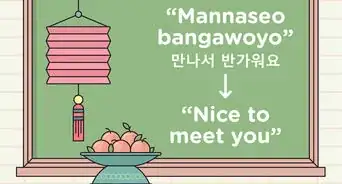
-Step-4.webp)


